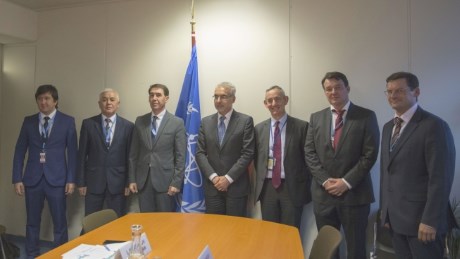The European Commission (EC), the European Bank for Reconstruction and Development (EBRD), the International Atomic Energy Agency (IAEA) and the republics of Tajikistan and Uzbekistan have signed a joint commitment on coordinating efforts to achieve the safe and sustainable environmental remediation of uranium legacy sites in Central Asia, under a newly published strategic master plan.
 |
| The parties at the signing ceremony (Image: IAEA) |
Central Asia was an important uranium-producing region in the former Soviet Union from the mid-1940s, particularly in the mountainous areas above the Syr Darya river and the Ferghana valley, where the borders of the Kyrgyz Republic, Kazakhstan, Tajikistan and Uzbekistan intersect. Most of the uranium mining and ore processing activities had ceased by the mid-1990s, leaving a large accumulation of radioactive contaminated material at mines and placed in waste dumps and tailing sites. Very little remediation of either mining sites or tailings storage facilities has been carried out.
The Strategic Master Plan has been developed with the Central Asian countries by core members of the IAEA's Coordination Group for Uranium Legacy Sites, which was formed in 2012 to help coordinate national and multilateral remediation activities in Central Asia. The plan aims to ensure a coordinated, timely and cost-effective approach in accordance with international conventions and agreements. It ranks remediation measures in terms of risks and priorities, and develops an integrated approach for evaluating the remediation needs of each site.
The plan was signed on 18 September by Tajikistan, Uzbekistan, the IAEA, the EC and the EBRD at the IAEA General Conference in Vienna. The Kyrgyz Republic and Russia are also expected to join it.
The overall costs of remediating the uranium legacy sites covered in the plan, together with supporting activities, are estimated at about €210 million. €56 million of this has already been provided by the European Union, the Commonwealth of Independent States and the World Bank. Most of the €160 million still required is for the cost of the actual remediation work.
Work on seven priority sites will be covered by the EBRD's Environmental Remediation Account for Central Asia at an estimated cost of €85 million, to which the EC has so far contributed €16 million. A donor conference is to be held next year with the aim of closing the funding gap, the EBRD said.
IAEA Deputy Director General Juan Carlos Lentijo, head of the agency's Department of Nuclear Safety and Security, said the partners were working together to help create a safe environment for current and future generations. "Effective coordination will help ensure that remediation will be addressed in a timely, cost-effective and sustainable manner," he said.
Balthasar Lindauer, EBRD Deputy Director, Nuclear Safety, said the bank welcomed the agreement. "This key document will be our joint roadmap for addressing the urgent issue of the legacy of uranium mining in Central Asia," he said. "Today's signing marks very important progress and also demonstrates the determination of all parties present today to address this challenge. We appeal to the international community to join this effort to create a safe and healthy environment for the people of Central Asia."
Researched and written
by World Nuclear News




_53514_33880.jpg)


_91467.jpg)





